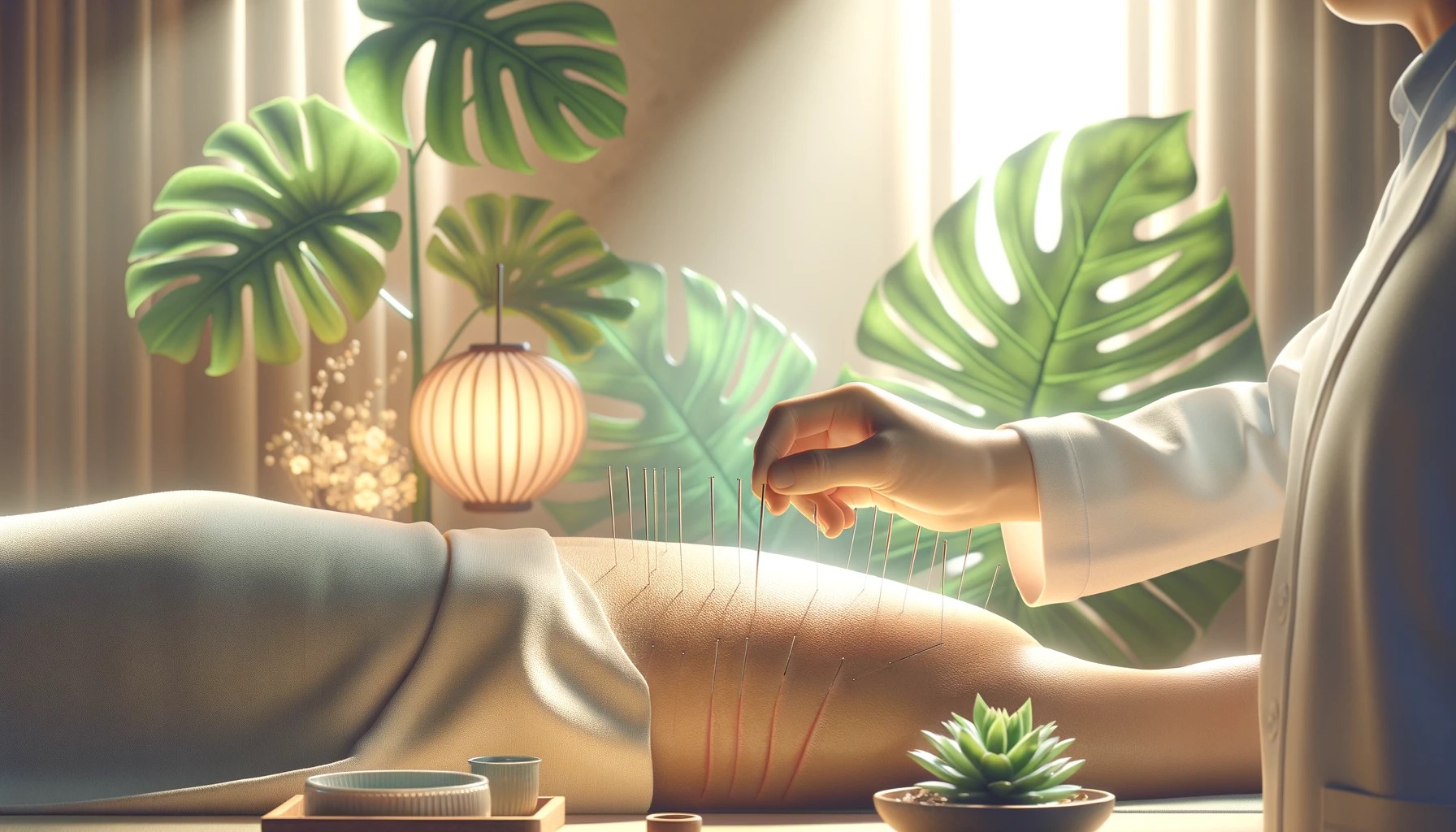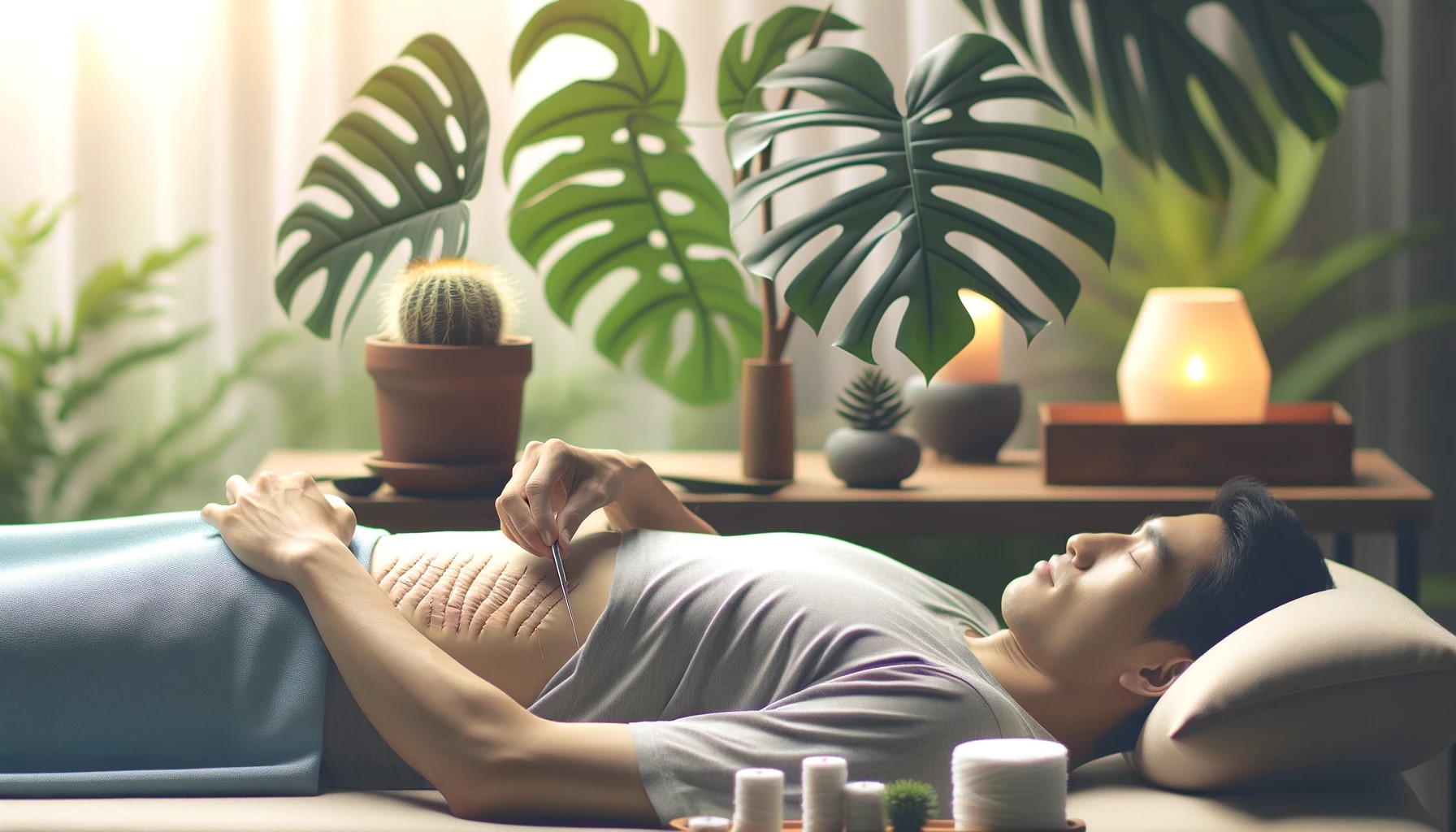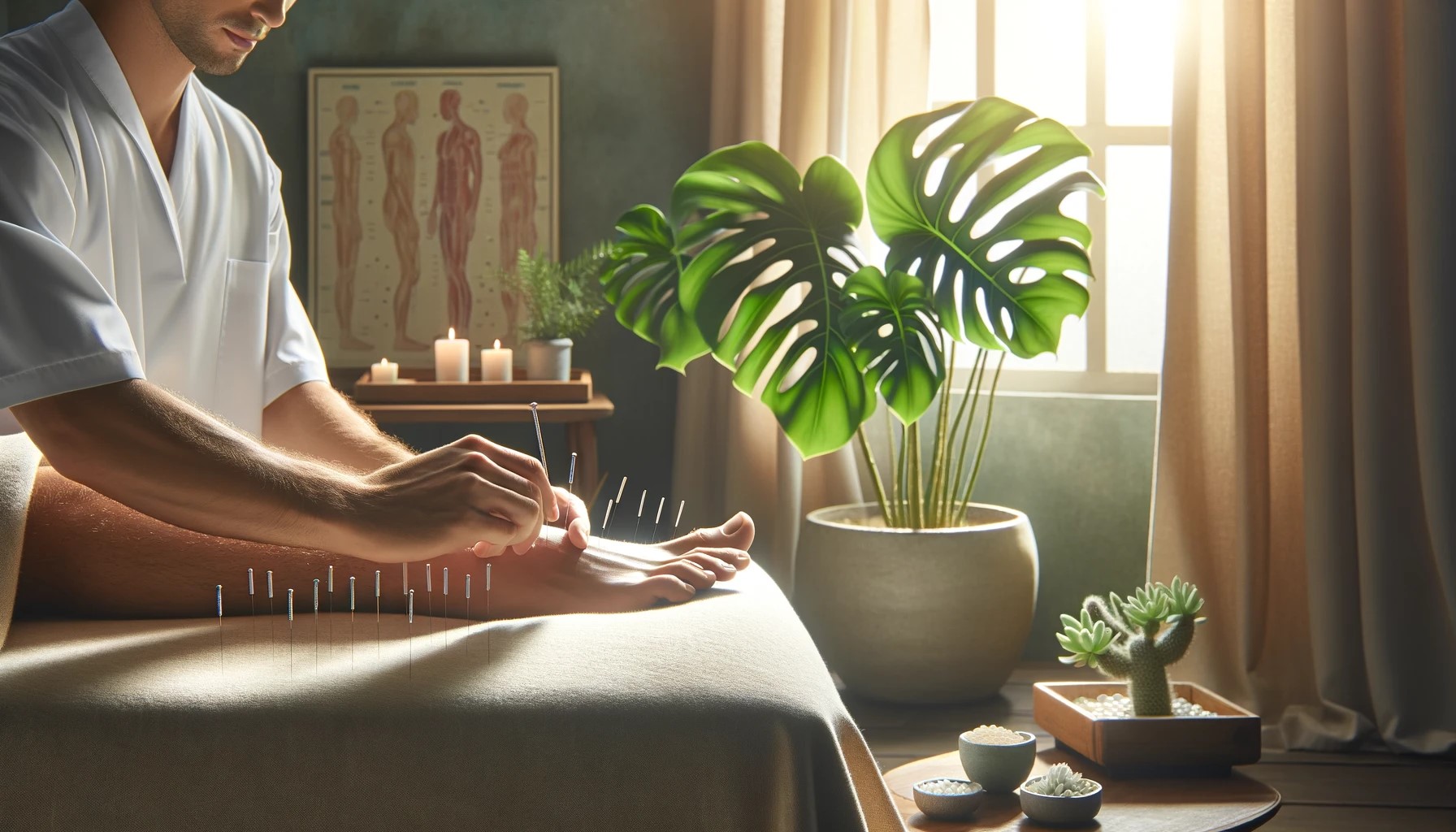| Disclaimer: For medical concerns, consult a healthcare professional; this content is for informational purposes only. |
Healing is a process, and sometimes you might run into issues like tough scar tissue after an injury or surgery. But there’s good news—acupuncture can help with that!
This article will take you through how acupuncture can be beneficial for scar tissue. You’ll find out how this age-old method can support your healing, help with scar tissue, and boost your overall health.
Dive straight into the heart of this subject, as we explore:
- Making sense of how acupuncture actually aids scar tissue healing.
- A peek behind the scenes of an acupuncture session.
- Essential do’s and don’ts to remember when considering acupuncture for scar tissue healing.
| Quick Fact |
| Though acupuncture’s history dates back thousands of years, recent clinical studies confirm its benefits in various aspects of health, including pain management, stress reduction, and tissue healing. |
What Leads to the Formation of Scar Tissue?
Scar tissue is the body’s natural response to healing after injury, surgery, or skin condition. When our skin is wounded, the body lays down collagen fibers to repair the site. These fibers, while vital for healing, are often arranged haphazardly compared to the organized structure of normal skin. This can result in tissue that is thicker, less elastic, and sometimes painful compared to the surrounding skin.
Factors influencing the formation and severity of scar tissue include the depth and size of the wound, the blood supply to the area, the thickness and color of one’s skin, and the direction of the wound. Underlying health conditions that affect healing, such as diabetes or a suppressed immune system, can also play a role. Furthermore, the body’s own healing process can sometimes overcompensate, leading to raised and enlarged scars known as keloids or hypertrophic scars.
- Surgical scars – resulting from incisions and closures of skin during operations.
- Traumatic scars – caused by injuries such as cuts, burns, or severe acne.
- Stretch marks – technically a form of scarring that occurs when rapid growth stretches the skin.
- Atrophic scars – resulting from skin conditions such as chickenpox or acne, where the scar tissue is sunken rather than raised.
What Makes Scar Tissue Worse?
Scar tissue can become more prominent or problematic in response to several factors. Neglecting the appropriate care during the initial healing phase can lead to thicker and more noticeable scars. Tension on the skin, particularly in areas where the skin moves frequently or is stretched, can worsen scarring. This is why surgical incisions in these areas often require extra attention to minimize scar formation.
Infections can heavily disrupt the healing process, causing more extensive scarring. Pulling at the edges of a wound can also delay healing and increase the scar’s size. Moreover, exposure to the sun can cause scar tissue to discolor and become more visible—UV rays can darken scars and make them stand out against the surrounding skin. Genetics also play a pivotal role; some individuals are prone to developing hypertrophic scars or keloids, which are thickened, raised scars that can grow beyond the boundary of the original wound.
Can Acupuncture Be an Effective Treatment for Pain in Scar Tissue?

As an intervention for dealing with the pain associated with scar tissue, acupuncture is being recognized for its efficacy. Pain in scar tissue often arises from nerve entrapment or the tight, inelastic nature of the scar pulling on surrounding tissues. Acupuncture aims to stimulate the nervous system, which can help to block pain signals and encourage the release of endorphins, the body’s natural painkillers.
Research points toward the potential of acupuncture to not only alleviate pain but to promote circulation and reduce inflammation, eventually leading to softer, more pliable scar tissue. A systematic review of studies concerning acupuncture and pain management indicates a significant correlation between the practice and reduced chronic pain intensity. This is encouraging news for anyone seeking alternatives to pharmaceutical interventions for the discomfort associated with scars.
What Are the Benefits of Acupuncture?
Acupuncture boasts a variety of benefits that extend beyond managing scar pain. It has been shown to play a role in:
Enhancing Circulation
The practice is believed to stimulate the flow of blood, which nourishes tissues and promotes healing. Enhanced circulation can lead to the reduced appearance of scars by supplying the necessary nutrients and oxygen required for tissue repair.
Reducing Inflammation
By triggering the body’s natural anti-inflammatory responses, acupuncture can alleviate swelling and redness around scar tissues, leading to a more favorable healing environment.
Encouraging Relaxation
Acupuncture often releases tension within the body, which not only aids in general relaxation but may also indirectly impact scar tissue. Relaxed muscles and reduced stress levels can contribute to a better healing process overall.
Regulating Immune Function
The needles used in acupuncture are said to stimulate the immune system. This can potentially benefit the healing of scars by fighting infection and supporting the body’s innate healing processes.
How Acupuncture Resolves Scar Tissues?
In addressing scar tissues, acupuncture targets the fibrous and often rigid tissue that has formed as a natural part of the body’s healing. The insertion of needles at specific points is thought to increase blood flow and modulate the body’s energy flow, or Qi, to the affected area, thereby promoting healthier, more resilient skin.
By improving circulation, acupuncture ensures that essential nutrients reach the scar site, which can be instrumental in breaking down the dense collagen fibers that make up scar tissue. Acupuncture can also stimulate fibroblast activity, cells responsible for collagen synthesis, and lead to the remodeling of the scar tissue. Over time, with consistent acupuncture treatment, scars may become less noticeable, smoother, and more similar in texture and color to the surrounding skin.
What Are the Stages of Healing with Acupuncture?
Healing is a dynamic process that unfolds in stages, and acupuncture can impact each phase of recovery. Let’s take a closer look:
The Initial Response
This first response to injury involves controlling bleeding and laying the groundwork for tissue repair. Acupuncture is believed to modulate this inflammation, not by eliminating it, but by possibly reducing excessive inflammatory responses that can lead to more significant scarring.
Proliferation and Repair
During this stage, the body builds new tissue and a temporary matrix that will eventually be replaced by stronger tissue. Acupuncture may influence this phase by promoting a regulated flow of energy and blood to the affected area, which can aid in the formation of a more organized matrix and subsequently decrease the potential for rugged scar tissue.
Remodeling
Finally, in the remodeling phase, scar tissue matures and strengthens. Acupuncture may aid inHere is where scar tissue strengthens and becomes more like the surrounding tissue. Acupuncture can contribute to a more pliable and less obtrusive scar during this extended phase, which can last for months to years post-injury. Stimulation from acupuncture may enhance tissue adaptability and alignment of the new collagen fibers, resulting in a softer and less noticeable scar. this process by encouraging a more organized formation of collagen, potentially leading to softer and less restrictive scars.
Complementary Therapies That Work Together with Acupuncture to Reduce the Appearance of Scar Tissues

The synergistic potential of combining acupuncture with other therapeutic modalities can significantly enhance the healing and appearance of scar tissue. These complementary therapies serve to amplify the benefits of acupuncture by addressing various physiological processes involved in scar formation and resolution. Here’s a deeper dive into some of these integrative approaches:
Massage and Manual Therapy
Through targeted manipulation, massage can increase local circulation and facilitate lymphatic drainage around the scar tissue. When paired with acupuncture, which also aims to improve blood flow and energy balance, massage can contribute to breaking down fibrous tissue, making it more supple and less noticeable.
Herbal Medicine
Within the context of traditional Chinese medicine, specific herbs are believed to possess properties that can assist in softening scars and fostering tissue healing. Herbal poultices or salves applied topically may accelerate healing and reduce inflammation when used in concert with acupuncture. Oral herbal supplements can provide systemic support for the body’s healing capacities.
Silicone Gel Sheeting
This is a non-invasive treatment often recommended for hypertrophic scars and keloids, and it can be used alongside acupuncture. By providing occlusion and hydration, silicone gel sheeting can flatten and soften the scar.
Physical and Occupational Therapy
Especially for scars that have resulted in impaired mobility or function, these therapies can be valuable adjuncts to acupuncture. They focus on exercises, stretches, and other modalities to improve range of motion and strength, which can be critical when a scar has limited movement.
Aromatherapy and Essential Oils
Certain essential oils, such as helichrysum and lavender, are reputed to support skin health and scar healing. They can be used in conjunction with acupuncture treatment to promote a sense of well-being and potentially enhance skin repair at the cellular level.
Platelet-Rich Plasma (PRP) Therapy
Although more research is needed, PRP injections, which use a concentration of a patient’s own platelets to accelerate healing, have shown promise in improving scar appearance. This therapy could potentially be integrated with acupuncture, though consultation with a healthcare provider is crucial.
How Do You Know If Acupuncture Is Working?
Identifying the effectiveness of acupuncture, especially in the context of scar tissue, can be subjective but there are signs to look for. Typically, patients may notice a decrease in pain and a sense of increased relaxation after sessions. For scar improvement specifically, signs of progress could be a softening of the scar tissue, lessened discoloration, and improved range of motion if the scar had been restrictive.
Over the course of several treatments, the changes might become more obvious. Regular follow-ups with your practitioner can help monitor these shifts, while photographic documentation of the scar over time can provide visual evidence of progress.
How To Speed Up Acupuncture Recovery
Maximizing the healing potential of acupuncture treatments, particularly for ameliorating scar tissue, involves a multi-faceted approach. Here are some extended strategies that can help expedite and enhance recovery:
Prioritize Good Nutrition
Nutritional support is the foundation of tissue regeneration. Consuming a balanced diet rich in vitamins A and C, zinc, and protein can support collagen synthesis and boost the overall healing process. Specific nutrients like vitamin E may also improve skin health and aid in the appearance of scars.
Augment with Herbal Medicine
In traditional Chinese medicine, herbal formulations are often prescribed in conjunction with acupuncture to support recovery. Herbs like gotu kola and ginseng have properties that are believed to improve circulation and skin health. Consult with a qualified herbalist to determine the right blend for your individual needs.
Stay Hydrated
Water is a critical component of cell life and function. Maintaining optimal hydration levels ensures that your body can effectively transport nutrients to the scar tissue and facilitate the removal of waste products.
Develop a Gentle Exercise Routine
Movement encourages a healthy blood flow that’s essential for healing. Gentle exercises, particularly those aimed at improving circulation to the affected area without placing undue stress on the scar, can complement your acupuncture treatments.
Incorporate Mind-Body Practices
Stress can hinder healing, making the integration of relaxation techniques such as meditation, yoga, or tai chi valuable allies in improving outcomes post-acupuncture.
Protect the Scar
External factors like UV radiation can impair scar healing. Protecting the scar from excessive sun exposure using clothing or sunscreen, and keeping the area clean and moisturized can prevent complications and promote faster recovery.
Rest Adequately
Adequate sleep is not just rejuvenating for the mind but also for the body. During sleep, the repair and regeneration processes are more active, so ensuring a good night’s sleep can enhance the benefits of your acupuncture sessions.
Follow Through with Consistency
The healing power of acupuncture is often cumulative, with the benefits building over time through consistent treatment. Adhering to the recommended treatment schedule set by your acupuncture practitioner is critical.
Side Effects of Acupuncture

While acupuncture is generally considered safe when performed by a qualified practitioner, there are potential side effects that patients should be aware of, including:
- Minor bruising or bleeding at needle sites
- Soreness or pain during needle insertion
- Drowsiness or relaxation after treatment, which could impair activities like driving
- Feeling lightheaded or dizzy, which is usually brief
Being informed about these potential side effects can help individuals prepare for their acupuncture experience and address any concerns with their practitioner beforehand.
How Long Is Acupuncture Effective?
The duration of acupuncture’s effectiveness varies greatly among individuals and the conditions being treated. For scar tissue improvement, some may notice changes shortly after the treatment begins, while for others, it may take weeks or months of consistent sessions to see visible improvements. The results can be long-lasting, especially when the underlying issue affecting the scar, such as restricted blood flow or inflammation, is resolved. However, continuous or periodic treatments may be necessary to maintain the benefits.
How Frequently Should You Have Acupuncture?
The frequency of acupuncture sessions should be personalized based on the individual’s response to treatment and the specific issue at hand. In the case of scar tissue, a practitioner may recommend starting with more frequent sessions—perhaps once or twice a week—and then gradually reducing the frequency as improvements occur. Consistency is key, and a tailored treatment plan should be developed in consultation with an experienced healthcare provider.
Final Thoughts
The journey through acupuncture as a means of improving scar tissue reveals a compelling blend of ancient wisdom and modern understanding. By encouraging the body’s natural healing processes and diminishing discomfort, this traditional practice offers an intriguing avenue for those seeking to soften the markers of past injuries. Whether viewed through the lens of improved circulation or the release of pain-relieving endorphins, acupuncture’s role in scar tissue treatment is a testament to the body’s remarkable capacity for renewal.
As with any medical treatment, it’s important to embark on acupuncture with realistic expectations and under the guidance of a skilled practitioner. Every individual’s experience with scar recovery will be unique, just as each scar tells its own story of healing. Wrapping up our exploration, acupuncture presents itself not just as a potential solution for mitigating the physical attributes of scars but also as a source of holistic wellbeing.
Frequently Asked Questions
Applying pressure can sometimes help in flattening raised scars and may be recommended as part of a scar management regimen. It’s essential to consult with a healthcare professional before starting any self-treatment for scars.
While acupuncture may not “remove” adhesions, it can help to alleviate the pain and dysfunction they cause. By promoting blood flow and healing, acupuncture could reduce the tightness and improve the flexibility of the involved tissues.
There’s no one-size-fits-all answer, as the treatment of scar tissue depends on many factors, including the scar’s age, size, and location. A combination of therapies such as massaging, specific exercises, heat application, and medical treatments like laser therapy and, in some cases, acupuncture may yield the quickest results. However, patience and consistency are key, as scar remodeling is generally a slow process.




